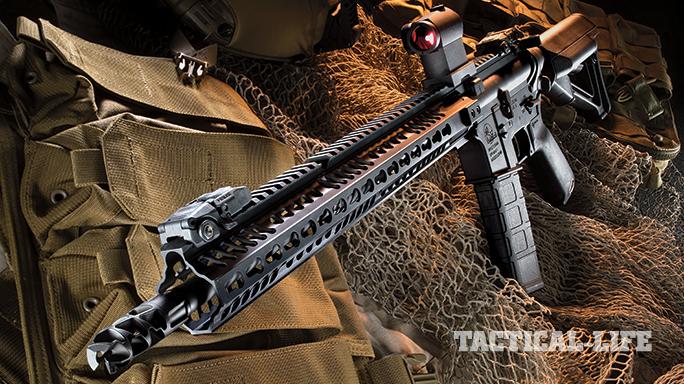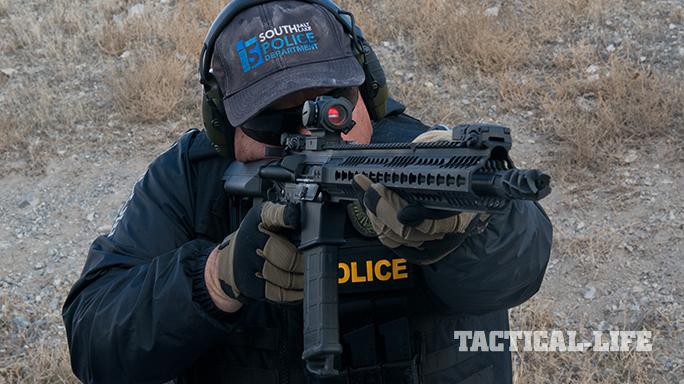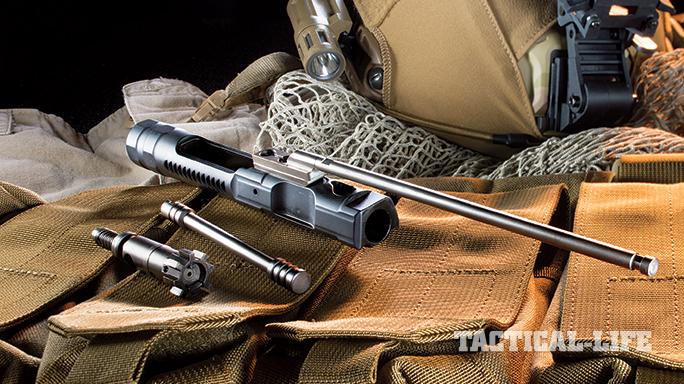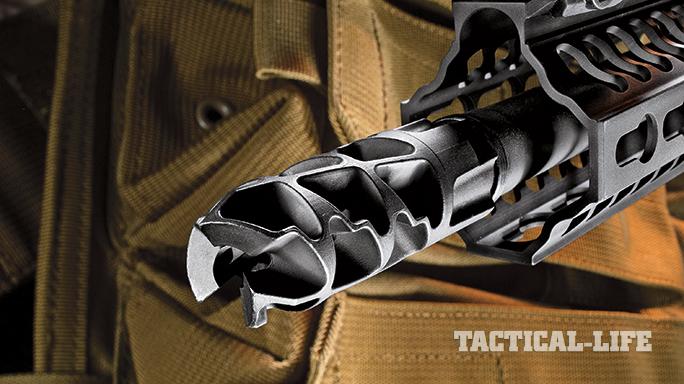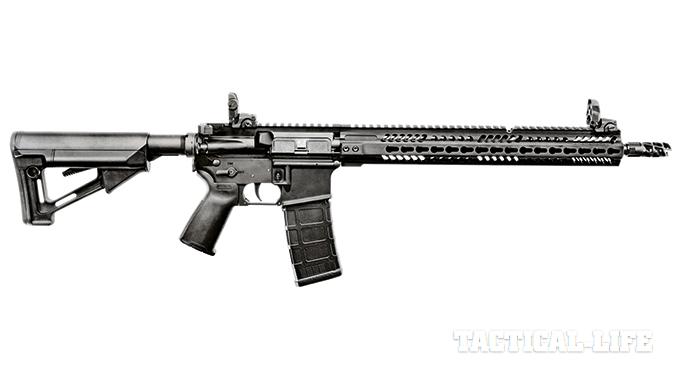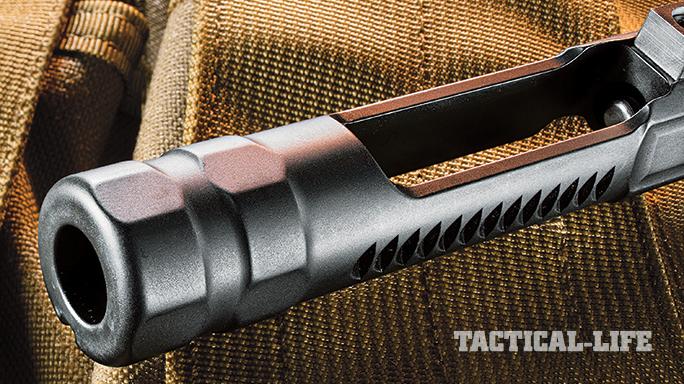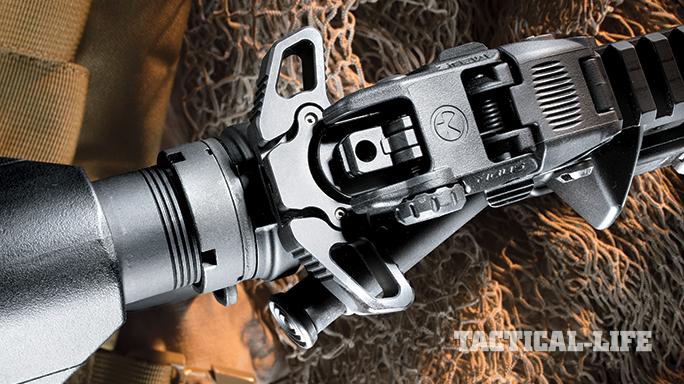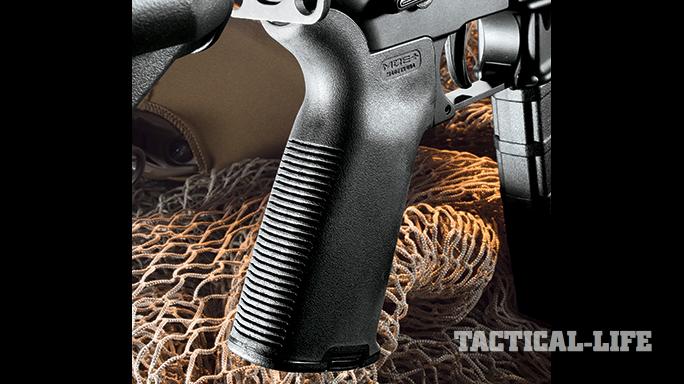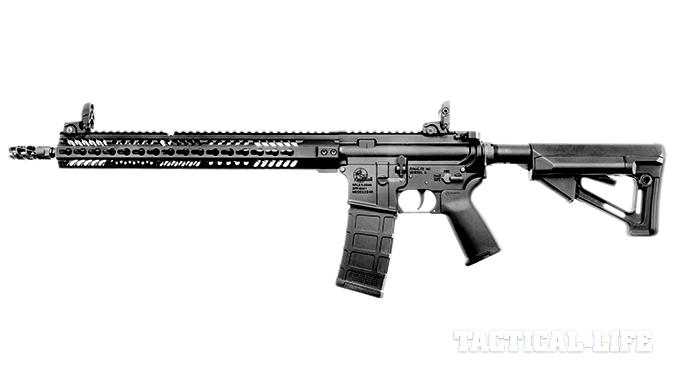Piston-driven rifles are popular for a number of reasons. Compared to direct-impingement ARs, they are generally more reliable, run cleaner and work better with sound suppressors. Most short-barreled AR rifles designed to be suppressed and used in adverse conditions are piston driven. With longer barrels, piston-driven rifles tend to be soft shooting and remain reliable under harsh conditions with a broad range of ammunition. For many professionals and enthusiasts alike, rifles with gas piston operating systems are the best choice.
Most are short-stroke tappet systems of varying designs. Gas is directed from the barrel gas port to a piston driving a rod into the bolt carrier. Some use a rod attached to the piston, while others have an intermediate rod with a very short “stroke” (the distance the rod travels). There are several variations of this design. Very common in short-barrel rifles, these systems solve many issues associated with a shorter dwell time, or the amount of time the bullet is in the barrel after passing the gas port. Sure, you can certainly use a short-barreled, direct-impingement AR, but adding a suppressor might hurt its reliability, making piston-driven guns more advantageous, especially in 5.56mm NATO.
Other systems try to mimic the well-known reliability of the AK-47 gas system. While some use bolt carriers and return spring changes, long-stroke systems retain the standard AR buffer and spring. The rod and piston are attached to the bolt, similar to the AK. This setup uses the best part of the AK system while maintaining a great deal of parts interchangeability with the AR. The gas tube is replaced with a piston tube, and the carrier key is replaced with one using a piston and rod. Having tested numerous rifles that utilize this long-stroke gas piston system, I know firsthand that it can be incredibly reliable, soft shooting and accurate.
Advertisement — Continue Reading Below
Tommy Thacker, the new president at Armalite, was a top 3-Gun shooter as part of the Primary Weapons Systems/FN Team. Tommy “Tommy Gun” Thacker has garnered national recognition and great respect as a competitor, and he’s brought much of that experience to Armalite. When it came time to build a piston-driven rifle, rather than cloning some existing system, it seemed simpler and more cost effective to employ a proven system. His experience with Primary Weapons Systems (PWS) rifles made that an easy decision. Armalite has now teamed up with PWS for its M-15 Piston rifle. In fact, PWS builds the upper receiver to Armalite’s specifications, which is then mated to an Armalite lower receiver, resulting in a reliable, piston-driven rifle made to Armalite’s standards.
Gun Details
The Armalite M-15 Piston utilizes the proven long-stroke piston operating system created by PWS. Adjustable for conditions, suppressor use or various ammunition, the four-position gas regulator is easily accessed. An Isonite QPQ-coated, 16-inch, 1-in-8-inch-twist barrel chambered in 5.56mm NATO is mounted to the forged upper receiver. M4-style cuts ensure proper feeding. Featuring 1/2×28 threading, the barrel is capped with an OSS Banner Flash Hider Muzzle Brake (FHMB). Surrounding the barrel is a free-floating handguard with a long Picatinny top rail. The 3, 6 and 9 o’clock positions feature KeyMod slots for adding accessories to the M-15 Piston. Magpul MBUS backup sights are included for mounting on the flattop upper receiver. Finally, AXTS’ Raptor charging handle is installed for ambidextrous use.
Advertisement — Continue Reading Below
The M-15 Piston’s forged lower is flared and nicely contoured. It features an ambidextrous safety—a really nice touch. The two-stage precision trigger is both fast and accurate. Rounding out the lower receiver is Magpul’s STR stock, another nice upgrade, and one 30-round PMAG is provided. Most mil-spec parts are compatible with the rifle.
To test the Armalite M-15 Piston at the range, I added an Aimpoint Micro T-2 sight along with Silencerco’s Saker sound suppressor and Trifecta flash suppressor/mount. I used all three of these add-ons during various drills. To wring out the M-15 Piston’s long-range accuracy, I mounted a U.S. Optics SR-6 1.5-6X scope with a JNG Mil reticle. This scope is a personal favorite of mine for smaller-caliber carbines. The reticle’s segmented circle allows for CQB operation where needed and fast targeting. Mil lines comprise most of the measurements, but line widths also include MOA measurements. The reticle is also mounted in the first focal plane, meaning it is precise at any power. Used on several rifles out to 800 meters, this scope has proven rock solid. All group shooting and long-range testing was completed with this U.S. Optics scope.
Range Time
Advertisement — Continue Reading Below
Repeatedly amazed at the accuracy of this particular piston system, the Armalite M-15 Piston was equally impressive. Shooting from prone using a bag as a rest, my best group, measuring just 0.6 inches, came with Winchester’s 69-grain Match ammo. This is the norm for this gas system—I’ve produced similar results even with short barrels—but the Winchester ammunition was very consistent. It is as accurate as any match-grade .223 ammunition I’ve ever tested, and the 69-grain bullet is better suited to some barrel twist rates. The rifle’s accuracy with the 77-grain match ammo was similar, but this rifle was accurate with every load I tested, including Black Hills’ 55-grain FMJs.
The Armalite M-15 Piston was able to maintain its sub-MOA accuracy at 300 yards, producing five-shot groups measuring just over 2.7 inches with Winchester 69-grain Match ammo. The weather was certainly not conducive to shooting groups, with plenty of wind and rain, so these results were pretty impressive. Given a calm day, my guess is that the rifle would create even tighter groups. Using the SR-6 scope, hits on a 6-inch steel target at 400 yards were consistent. With this kind of accuracy, this scope/rifle combination would prove viable for many mission profiles. The two-stage trigger was smooth, crisp and predictable, allowing for pinpoint precision when needed.
Aimpoint’s Micro T-2 is one of the best choices you can make in a red-dot sight, especially where CQB is the norm. Moving through the shoothouse at my range, the T-2 was extremely fast on target. The M-15 Piston acquitted itself well, working easily around corners and through doors. Sure, shorter barrels have their advantages, but they are loud and can be little flamethrowers with standard flash suppressors. Lately my preference has been for 16-inch barrels in 5.56mm ARs. There’s no NFA paperwork to deal with, and these barrels offer effective ballistics and reliability no matter the gas system. Whether dedicated to entries or patrol duties, the Armalite M-15 Piston should prove excellent. Shooting indoors with the OSS Banner is better than a standard A2 flash suppressor with just a bit of recoil control, although it is a 360-degree muzzle device—just be careful from prone. Using the Silencerco Saker Trifecta flash suppressor was enjoyable. The muzzle blast was minimal and flash was almost non-existent. If you intend to use a Silencerco Saker suppressor, this would be my first choice, but it also serves well as a standalone flash suppressor.
Advertisement — Continue Reading Below
Suppressing piston-driven rifles like the M-15 Piston can be a mixed bag. Recoil can actually increase, especially with short-stroke tappet systems. Long-stroke designs like the kind used in this rifle are better, but you notice a difference. You still get gas back in your face—piston systems do not eliminate it. Yes, it can be better than a direct-impingement system, but not always. The more backpressure created by the suppressor, the more excess gas is sent your way. Silencerco’s Saker is moderate when it comes to backpressure and gas blowback. The sound suppression is excellent, the recoil remains soft and it produces less excess gas than many models currently on the market.
Attaching and removing the suppressor is easy. Properly installed, the Saker just does not come loose. I’ve used this suppressor with several guns, and it seldom shoots loose when properly tightened. Shifts in the point of impact are minimal when removed and reattached using the Trifecta three-pronged flash suppressor. The rifle’s accuracy was unaffected even at the longer ranges. Longer ranges will see more difference in the point of aim (added elevation). Adding a pound to your barrel has consequences—there’s no way to get around that—but just hold a bit higher or turn your scope knobs.
With the Saker suppressor, ejection became a bit less consistent, but the M-15 Piston remained accurate and reliable. On the square range, the M-15 Piston never malfunctioned, even during rapid fire. Running the trigger hard, it is pretty fast yet controllable. Two-stage triggers are great, but the second stage needs to be heavier for duty use. This trigger remained predictable and controllable over several high-speed drills. If you are going to move to the gaming world, a light 3-Gun trigger may be in order, but for most uses, the factory trigger will be just about perfect.
Advertisement — Continue Reading Below
Final Notes
Given my experience with the PWS operating system, I expected top-notch accuracy and reliability—and the Armalite M-15 Piston certainly delivered. This is an excellent rifle suitable for duty, practice, competition or just about any use. Out of the box, it is equipped with an ambidextrous safety and charging handle, backup sights and an excellent stock. If you are in the market for a new Armalite and want a piston-driven rifle, the M-15 Piston is just the ticket!
For more information on the M-15 Piston, visit armalite.com or call 800-336-0184.
Advertisement — Continue Reading Below
